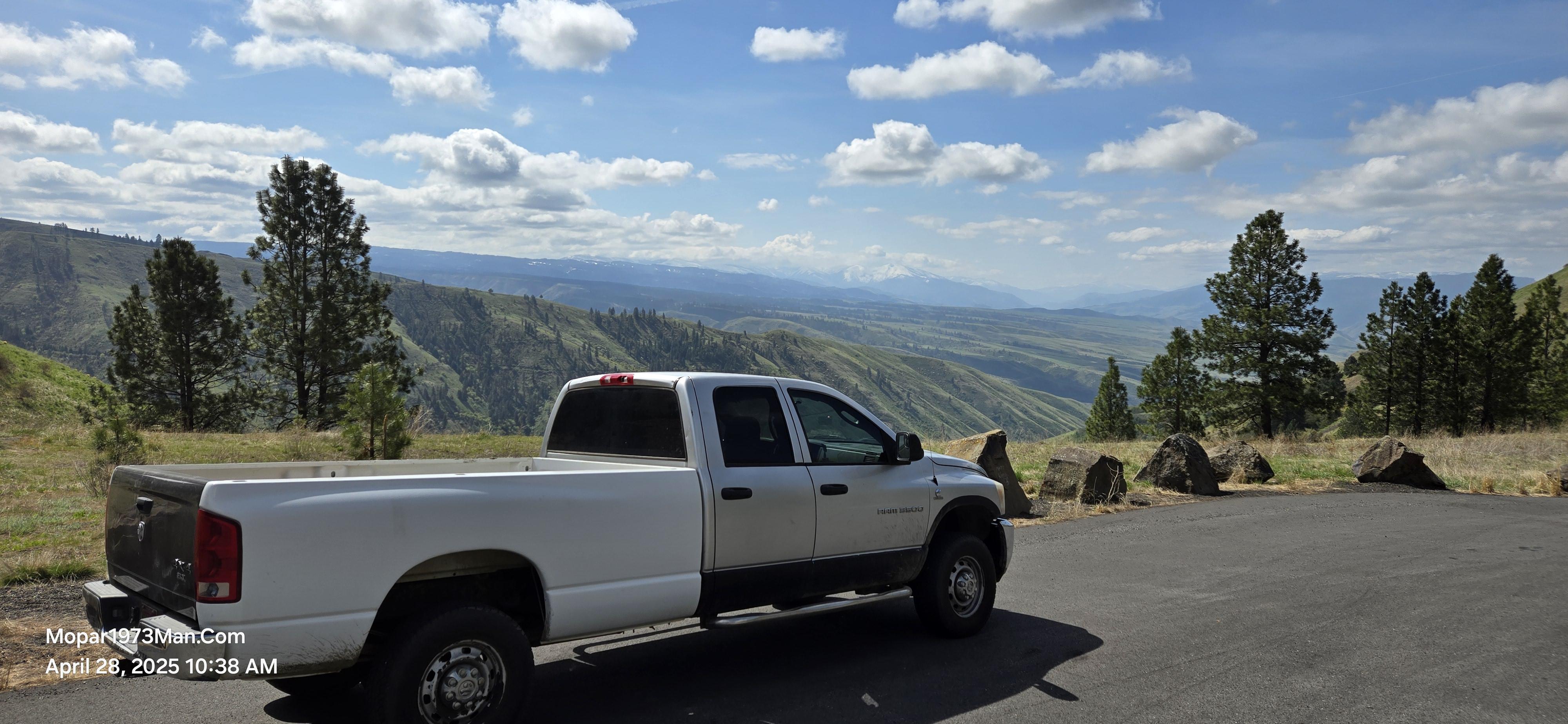
Everything posted by Mopar1973Man
-
Quadzilla Rail Pressure Gauge
From talking to guys over at TDG.com I found that 27K is about your limit without blowin' up your injectors...But 6K to 7K is about right for idle... ;)
-
Here is a poll of fuel additives
See you dumb idea and my backing has made a difference in the world! :thumbsup Some day if I ever see you I got to buy you a beer! :cheers
-
Wood haul...
Well once again gang... I've been busy in the wood cutting firewood with a good friend Taz... I figured I would put a few pics up of the fun and hard work we had with the trucks... :D Hey Taz it might help if your hooked up to the tree... LOL After a good long fight Taz let me hook up and do the pulling after his clutch started slipping... I got the tree pulled up on the road... Taz is felling pretty fat... LOL Days done... Everything unloaded...
-
Quick stop at the bank...
Keydl is so right...The canopy was designed to hold downward weight forces not being stuck from the side by a big 5th wheel trailer... But it shows how easy it is to forget that the big monster is behind you when driving a Dodge Cummins... I heard more that once from people saying that "you can't even feel the trailer back there!" :confused
-
ULSD....
I would be very careful about mixing 2 cycle oil with newer 5.9L and 6.7L engines. I know the 6.7L are having problems with just ULSD and the DPF but as for the 5.9L I got very little information. I would say there is no real need for adding 2 cycle oil to ULSD fuel. Being that all the fuel system is designed for ULSD. The idea of cleaning is a myth... My truck has never in its life seen BIO fuels ever... Take a look at my fuel tank after 6 years and 127K miles... The little black bits are the drill crumbs from the draw straw install... What is happening is the BIO fuel is eating at different materials in the fuel system like rubber o-ring (older vehicles) and such... There have been finding that some sources don't wash or filter there fuel properly either... That is why everyone is complaining about having to change the fuel filters so often. The methanol and lye tends to be great solvents but they also attack some materials... I've got another thread here on BIO-fuels as well... viewtopic.php?f=14&t=267 viewtopic.php?f=14&t=117 So be careful and know your source concerning BIO-fuels...
-
Here is a poll of fuel additives
Here you go gang... Someone over at TDG.com started a poll asking about what fuel additives they are using over at TDG.com. Surprise! I really did make a difference in all my hard work and studing... :thumbsup http://www.thedieselgarage.com/forums/s ... hp?t=67786
-
Fuel Additives Again
Thanks Jeff...But only one thing let me straighten out your math there bud...Most Dodge trucks are 35 gallon fuel tanks. 35 gallon tank x 128 ounces in a gallon = 4,480 ounces of fuel128:1 ratio is needed for 2nd Gen's...4,480 Ounces of fuel / 128:1 Ratio Mix = 35 ounces of oilSo basically if the tank holds 35 Gallons you would add 35 ounces of oil on first dose. After that you pump in 10 gallons you need 10 ounces of oil. Then in you only pump 12.8 just added 13 Ounces of oil... Really simple... :thumbsup
-
Chrysler gas engines
Wow! That is quite the work of love put into that rig... :thumbsup As for dual points... funny thing I put a Mallory dual point distributor in my 73 Charger for the simple reason of the stock brain box keep frying out on my and leaving my stuck somewhere... Dual point dist. really work well...Stange that the 2 boxes are not keeping the mice out... :confused: It working quite well for my car that is sitting under a tree... 8|
-
Chrysler gas engines
Like what kind of problems are you having with it??? I've got a ultra-sonic box in my 73 Charger and it keep the mice out of the interior of the vehicle... The day I get started on my 73 it will be a money pit... It got so much to repair... :wow
-
Smarty
Well dang Joe your finally getting really close to me now... You only got another 2 MPG gain to catch me... :thumbsup I gather your still adding 2 cycle oil in your fuel?? What ratio???
-
Vacation??
LOL... What can I say... :confused:
-
Smarty
True... But the paper and pencil only works really good if you make sure you write down all your fuel that you purchase... You know what my fuel notebook looks like... LOL 8|
-
Vacation??
Yeah I know... :rolleyes Hopefully here really soon I can get free from my labor camp... LOL
-
Buried my truck..
Oh that had to suck big time... I got to admit good aggressive tires have there place in the mud and snow... LOL
-
CAI... in winter?
Well after studying the IAT sensor and the effect it has on MPG... It seem that when the IAT sees temps of about 120-140*F it seem to produce the best MPG. So the winter fronts should help greatly with MPG in the winter time since the fuel rates are based off of ECT, IAT and MAP sensors...
-
Synthetic 2 cycle oil usage.
Well since you didn't fill out your signature It's really hard for me to see what year of truck ya got... But... All 1st and 2nd Gen Dodges can handle up to 100:1 ratio without any problems. But 128:1 ratio is standard. (1 oz of oil for every gallon of fuel). It only the 3rd gen trucks that are a bit touchy... you can got as low as 200:1 ratio and as high as 256:1 ratio... (Basically 1/2 oz of oil for every gallon of fuel)... Here is more on this... http://mopar.mopar1973man.com/cummins/general/2-cycle-oil/failure/failure.htm
-
Stuff --
That sound really interresting there Keydl... Do you happen to have any pics of this design??? :confused:
-
Vacation??
Man... I wish I had it as good as you guys do... Some how, some way I'm always busy and always working... :mad
-
Smarty
This is where you need t upgrade to a ScanGauge II... But I know your truck won't work with it... As a matter of fact the ScanGauge II hooks up to the OBD II port under the dash but it can read any of the sensors or error codes... Yes... I had a customer call me with starting problems and his DOM is 01/2004.But I guess the hand written notebook and Excel sheet will have to do... :rolleyes
-
Quadzilla Rail Pressure Gauge
I would say get the gauges before you turn it up much so you don't pop something... http://www.danininc.com/optix/gauge/200140.htm
-
Smarty
Dang... That was quick... LOL Now I would love to see some hard data from you on the Smarty... MPG, Dyno, 1/4 mile times etc... 8| :wow
-
Smarty
I guess your going to have to change up your signature now... LOL
-
Smarty
Well that cool. Now did you try it stacked against your Edge yet??? :confused: I'm waiting to see you reaction to that.... LOL
-
Quick stop at the bank...
I just need to stop at the bank before we leave town... LOL http://good-times.webshots.com/video/30 ... 8671ERGBsx <- Watch the video... 8|
-
Chrysler gas engines
I love the old 360 block myself they were a killer engine to play with and easy to work on! :thumbsup


